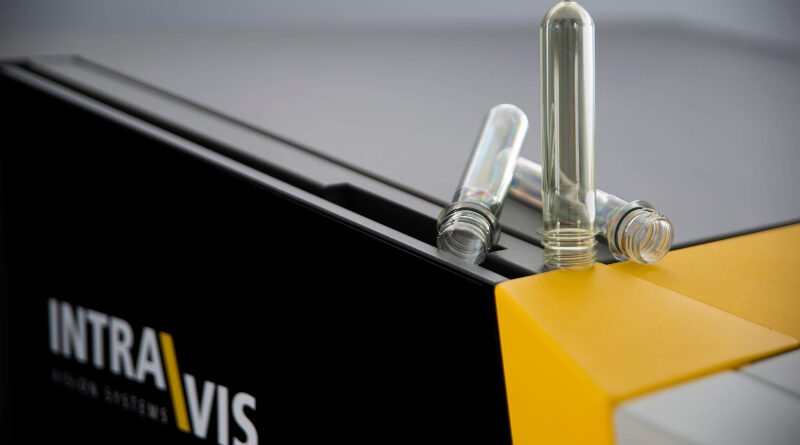Monitoring rPET preforms
Inline inspection also for colour deviation
In recent years, the proportion of recycled material in preforms has gradually increased – initially for reasons of cost and image, and recently because it was required by law. Although this regulation makes sense from the point of view of resources conservation, the use of rPET has some negative effects on the quality of the preforms. To address these directly, it makes sense to have a monitoring system in the production line that is fully dedicated to inspecting recycled preforms.
Yellowing is certainly the most obvious quality-reducing effect that occurs when rPET is used to produce preforms. By yellowing, a slight discouloration of the preform caused by the recycled material is meant. Just imagine how water can look in a yellowed PET bottle for the end consumer. That is why the yellowing effect is considered particularly critical by any preform producer.
Targeted inspection for yellowing
Intravis launched the preform monitoring system PreMon which is used inline directly behind the injection moulding machine. It provides comprehensive information about the products’ quality to the system operator. It has been optimised especially for the inspection of rPET preforms: In addition to the inspection of typical criteria such as contaminations in the body area as well as short shots and defects at the sealing surface, the PreMon also features a sophisticated colour inspection that outputs an explicit yellowing value. Thus, the operator can immediately determine the influence more or less rPET has on the quality of the produced preforms and can react accordingly, for example by adding certain additives.
Clear dashboards to keep track of production
As a monitoring system, the PreMon provides its operator with a comprehensive quality picture without the need to thoroughly inspect each preform. The data and information obtained is presented in a newly designed dashboard. The PreMon’s Octabin Statistics will provide the information which is needed. If one would rather find out about the quality of the whole production based on a time interval or specific inspection criteria, then the PreMon supports data with the IntraVision statistics dashboard.
A special feature of the PreMon is the so-called ejection compensation. In addition to shot counting, the PreMon offers an ejector as an optional extension. Both combined, the operator is able to control the amount of preforms in his octabins in a targeted manner, and to actively influence the quality in his octabins. If a specified amount of defective preforms are ejected, the PreMon compensates this number by adding an additional shot to the octabin. In this way, the PreMon ensures that not only the preform quality increases but also that the quantity delivered per octabin is always approximately the same.
Product reference
The setup of a new product is one of the essential tasks of the operator of a vision inspection system like the PreMon. Thanks to the product reference, the system can detect which products meet the specified quality standards and which do not. If this product reference is set incorrectly or not optimally, it has a lasting effect on the inspection quality and the corresponding customer satisfaction.
With the new PreMon software add-on Wizard the reference creation becomes easier for the operator. The Wizard actively supports the operator in finding the optimal settings. The operator is guided through the setup process by simple steps, some of which are even carried out automatically by the system. In this way, the operator can create a new reference with only a few steps – even while the production process is running, and the products are being inspected.
With the PreMon, Intravis has already had a system in its portfolio for several years which, due to its inspection criteria, is suitable for the application in preform production lines that increasingly rely on recycled material. With new developments at software level – the informative dashboards, ejection compensation as well as the PreMon Wizard – the system contributes the desired information for decision making and immediate production optimisation.

